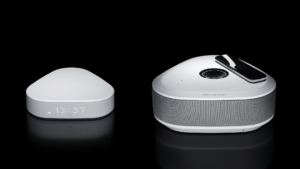Amazon starts Voice Interoperability Initiative for voice-driven assistant technology
Articles
Amazon Creates A Huge Alliance To Demand Voice Assistant Compatibility | The Verge
Amazon launches Voice Interoperability Initiative — without Google, Apple or Samsung | ZDNet
Amazon enlists 30 companies to improve how voice assistants work together | Engadget
From the horse’s mouth
Amazon
Voice Interoperability Initiative (Product Page)
My Comments
Amazon have instigated the Voice Interoperability Initiative which, at the moment, allows a hardware or software device to work with multiple compatible voice-driven AI assistants. It also includes the ability for someone to develop a voice-driven assistant platform that can serve a niche yet have it run on commonly-available smart-speaker hardware alongside a broad-based voice-driven assistant platform.

Freebox Delta as an example of a European voice-driven home assistant that could support multiple voice assistant platforms
An example they called out was to run the Salesforce Einstein voice-driven assistant that works with Salesforce’s customer-relationship-management software on the Amazon Echo smart speaker alongside the Alexa voice assistant. Similarly, a person who lives in France and is taking advantage of the highly-competitive telecommunications and Internet landscape there by buying the Freebox Delta smart speaker / router and have it use Free.fr’s voice assistant platform or Amazon Alexa on that same device.
Microsoft, BMW, Free.fr, Baidu, Bose, Harman and Sony are behind this initiative while Google, Apple and Samsung are definitely absent. This is most likely because Google, Apple and Samsung have their own broad-based voice-driven assistant platforms that are part of their hardware or operating-system platforms with Apple placing more emphasis on vertically-integrating some of their products. It is although Samsung’s Android phones are set up to be able to work with their Bixby voice assistant or Google’s Assistant service.
Intel and Qualcomm are also behind this effort by offering silicon that provides the power to effectively understand the different wake words and direct a session’s focus towards a particular voice assistant.
The same hardware device or software gateway can recognise assistant-specific wake words and react to them on a session-specific basis. There will be the ability to assure customer privacy through measures like encrypted tunnelling for each assistant session along with an effort to be power-efficient which is important for battery-operated devices.
Personally I see this as an ability for companies to place emphasis on niche voice-assistant platforms like what Salesforce is doing with their Einstein product or Microsoft with its refocused Cortana product. It can even make the concept of these voice assistants more relevant to the enterprise market and business customers.
Similarly, telcos and ISPs could create their own voice-driven assistants for use by their customers, typically with functionality that answers what they want out of the telco’s offerings. It can also extend to the hotel and allied sectors that wants to use voice-driven assistants for providing access to functions of benefit to hotel guests like room service, facility booking and knowledge about the local area. Let’s not forget vehicle builders who implement voice-driven assistants as part of their infotainment technology so that the drive has both hands on the wheel and eyes on the road.
This kind of offering can open up a market for the creation of “white-label” voice-assistant platforms that can be “branded” by their customers. As well, some of these assistants can be developed with a focus towards a local market’s needs like high proficiency in a local language and support for local values.
For hardware, the Amazon Voice Interoperability Initiative can open up paths for innovative devices. This can lead towards ideas like automotive applications, smart TVs, build-in use cases like intercom / entryphone or thermostat setups, software-only assistant gateways that work with computers or telephone systems amongst other things.
With the Amazon Voice Interoperability Alliance, there will be increased room for innovation in the voice-driven assistant sector.









